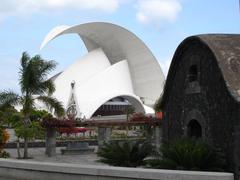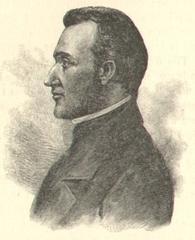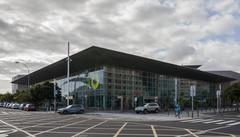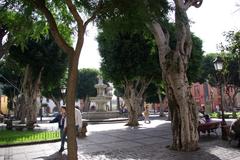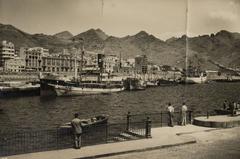
Torres de Santa Cruz: Visiting Hours, Tickets, and Complete Guide to Santa Cruz Historical Sites
Date: 04/07/2025
Introduction
Rising dramatically above the port city of Santa Cruz de Tenerife, the Torres de Santa Cruz are a pair of soaring skyscrapers that have come to symbolize the city’s transformation into a modern, cosmopolitan capital. As the tallest buildings in the Canary Islands, these twin towers are not just feats of engineering and architecture—they are powerful markers of economic revival, cultural ambition, and urban renewal. Whether you’re an architecture enthusiast, a cultural explorer, or a curious traveler, this comprehensive guide covers everything you need to know about visiting the Torres de Santa Cruz, from practical visitor information and historical context to nearby attractions and insider tips.
(Spain.info, Technical Parameters, Emporis)
Table of Contents
- Early Urban Development and the Rise of Santa Cruz de Tenerife
- Vision and Construction of the Torres de Santa Cruz
- Architectural Significance and Technical Innovations
- Symbolism, Urban Impact, and Cultural Role
- Visiting Hours, Tickets, and Accessibility
- Guided Tours and Photography
- Nearby Attractions and Travel Tips
- Practical Visitor Advice
- Frequently Asked Questions (FAQ)
- Summary and Call to Action
- References
Early Urban Development and the Rise of Santa Cruz de Tenerife
Santa Cruz de Tenerife’s roots stretch back to the late 15th century, when its coastal location made it a vital port for trade and cultural exchange. Over the centuries, the city evolved from a small fishing village into the vibrant economic and administrative capital of Tenerife, marked by a mixture of colonial, rationalist, and modernist architecture. The city’s growth accelerated in the 20th century, setting the stage for ambitious urban renewal projects in the new millennium. (Spain.info)
Vision and Construction of the Torres de Santa Cruz
By the turn of the 21st century, Santa Cruz was poised for modernization. City planners envisioned landmark skyscrapers that would represent a new era of prosperity and cosmopolitanism. The result was the Torres de Santa Cruz, designed by Canarian architect Julián Valladares and developed by Grupo Inmobiliario de las Islas Occidentales. Construction began in 2001, with the first tower completed in 2004 and the second in 2006. The project overcame significant challenges, including a severe storm in 2002 that necessitated a redesign and reinforcement of the structures. (Technical Parameters, Emporis)
At 120 meters tall, each of the two towers became the tallest buildings in the Canary Islands and, for a time, the tallest residential towers in Spain. Their completion marked a turning point in the urban development of Santa Cruz, setting a precedent for high-rise, mixed-use projects in the region. (Wikipedia, Tenerife.ca)
Architectural Significance and Technical Innovations
The Torres de Santa Cruz are celebrated for their striking modernist design, characterized by sleek glass and steel facades that reflect both the sky and sea. Their twin configuration—two identical towers placed parallel to each other—creates a powerful visual axis visible from across the city and the harbor. This layout is rare in Spain and has become a defining element of the Santa Cruz skyline. (ArchDaily, Wanderlog)
Engineering and Sustainability
The towers are built with reinforced concrete cores and steel frameworks, ensuring stability in the face of the region’s seismic risks and Atlantic winds. Advanced engineering techniques allow for open-plan residential and commercial spaces, maximizing natural light and panoramic views. Energy-efficient glazing, natural ventilation, and double-skin facades contribute to the towers’ sustainability. Accessibility and fire safety are also prioritized, meeting rigorous European standards. (Technical Parameters, WikiArquitectura)
Symbolism, Urban Impact, and Cultural Role
The Torres de Santa Cruz are much more than architectural marvels—they are enduring symbols of Santa Cruz’s urban renewal and economic vitality. Their presence anchors the city’s skyline, signaling progress and a forward-looking identity. Located in the commercial heart of the city, near landmarks such as the Auditorio de Tenerife and the Palmetum botanical gardens, the towers have spurred further development and revitalized the surrounding district. (Canarias Lovers, Lonely Planet)
The towers are also cultural icons, often featured in Carnival celebrations, art exhibitions, and promotional materials. They provide a striking backdrop for festivals and public gatherings, reinforcing their role as a focal point of community life and tourism. (Turismo de Tenerife)
Visiting Hours, Tickets, and Accessibility
Visiting Hours & Tickets
- The Torres de Santa Cruz function as residential and office buildings; there is no public access to the interiors.
- The surrounding plazas, promenades, and public areas are open daily, generally from early morning until late evening.
- No tickets or admission fees are required to visit the exterior or public spaces.
Accessibility
- The area around the towers is fully wheelchair accessible, with ramps, wide sidewalks, and easy access to public transportation.
- Parking facilities are available nearby for those arriving by car.
(Technical Parameters, Nomads Travel Guide)
Guided Tours and Photography
While the towers themselves are not open for interior tours, many city walking tours include the Torres de Santa Cruz as a highlight, offering expert commentary and excellent photo opportunities. Local tourism offices and operators provide up-to-date schedules for guided tours. (Wanderlog, GPSmyCity)
Photography Tips:
- Best light is at sunrise or sunset, when the towers’ glass facades reflect the sky and ocean.
- Vantage points include the waterfront promenade, Parque Marítimo César Manrique, and the rooftop terrace of El Corte Inglés department store. (TripAdvisor)
Nearby Attractions and Travel Tips
The district surrounding the Torres de Santa Cruz is rich in attractions, shopping, dining, and green spaces:
- Auditorio de Tenerife: Santiago Calatrava’s architectural masterpiece, offering performances and tours (Auditorio de Tenerife).
- Palmetum de Santa Cruz: A unique botanical garden specializing in palm trees (Palmetum).
- Parque Marítimo César Manrique: Oceanfront pools, gardens, and recreational facilities (Parque Marítimo).
- Centro Comercial Meridiano: Shopping, dining, and entertainment for all ages (Meridiano).
- Plaza de España: The city’s main square, surrounded by historic buildings and vibrant cafes.
Travel Tip: The area is well-served by public transport, including bus and tram lines. Santa Cruz is pedestrian-friendly, making it easy to explore on foot.
Practical Visitor Advice
- Best Time to Visit: Year-round, with optimal weather and light for photography from late spring to early autumn.
- Events: The area comes alive during Carnival and other city festivals—check local calendars for event dates (Carnaval de Santa Cruz).
- Dining: Enjoy everything from traditional Canarian fare at La Hierbita (La Hierbita) to the Michelin-starred Restaurante Kazan (Kazan).
- Amenities: The neighborhood offers supermarkets, pharmacies, ATMs, and accessible facilities for visitors with reduced mobility.
Frequently Asked Questions (FAQ)
Q: Can I enter the Torres de Santa Cruz?
A: No, public access to the towers’ interiors is generally restricted to residents and tenants.
Q: What are the visiting hours?
A: The surrounding plazas and promenades are open daily from early morning to late evening.
Q: Are guided tours available?
A: Yes, some local operators offer walking tours that include exterior views and history of the towers. Check with the Santa Cruz tourism office for current listings.
Q: Where can I photograph the towers?
A: The waterfront promenade, Parque Marítimo César Manrique, and the El Corte Inglés rooftop terrace provide excellent vantage points.
Q: Is the area accessible?
A: Yes, the district is fully accessible, with ramps, smooth pathways, and accessible public transport.
Summary and Call to Action
The Torres de Santa Cruz are more than just the tallest buildings in the Canary Islands—they are a testament to Santa Cruz de Tenerife’s forward-thinking spirit and cosmopolitan identity. While interior access is limited, the surrounding public spaces, vibrant neighborhood, and nearby attractions offer ample opportunities for exploration, photography, and cultural immersion. Plan your visit to experience these architectural icons and the dynamic urban life that surrounds them.
For up-to-date information, guided tour options, and interactive maps, download the Audiala app and follow official tourism and city channels. Stay engaged with Santa Cruz’s ever-evolving cultural scene and make the most of your visit to this remarkable city.
References
- Spain.info
- Technical Parameters
- Emporis
- Wikipedia
- Wanderlog
- ArchDaily
- Canarias Lovers
- Lonely Planet
- Turismo de Tenerife
- TripAdvisor
- Palmetum
- Auditorio de Tenerife
- Parque Marítimo
- Meridiano
- La Hierbita
- Kazan
- Carnaval de Santa Cruz
- GPSmyCity
- Nomads Travel Guide
- WikiArquitectura

